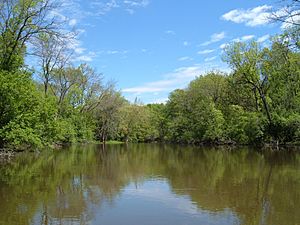Des Plaines River facts for kids
The Des Plaines River is a cool river that flows for about 133 miles (214 kilometers) through parts of southern Wisconsin and northern Illinois in the United States. It starts in Wisconsin and winds its way south. Eventually, it joins another river called the Kankakee River near a town called Channahon. When these two rivers meet, they form the Illinois River. The Illinois River then flows into the mighty Mississippi River. So, the Des Plaines River is like a smaller stream that helps feed one of America's biggest rivers!
The Des Plaines River: A Journey Through Nature
The Des Plaines River is more than just a waterway. It has played an important role in the history and nature of the areas it flows through. Rivers like the Des Plaines are vital for many reasons. They provide homes for wildlife and offer places for people to have fun outdoors.
Where Does the Des Plaines River Flow?
The Des Plaines River begins its journey in Kenosha County, Wisconsin. From there, it flows south into Illinois. It travels through several counties, including Lake, Cook, and Will counties. As it moves, it passes through many towns and cities. These include places like Des Plaines, Joliet, and Lockport.
What Makes the River's Path Special?
The river's path is quite interesting. In some areas, it flows through natural forests and wetlands. These areas are important for filtering water and providing habitats for animals. In other parts, it flows through more developed areas. Here, it might pass by parks or even industrial sites. The river's journey shows how nature and human communities can exist side by side.
Why Is This River Important?
The Des Plaines River has been important for a long time. Native American tribes lived along its banks for thousands of years. They used the river for travel, fishing, and water. Later, European settlers also found the river useful.
A Historic Waterway
In the past, the Des Plaines River was part of a major travel route. People used it to connect the Great Lakes to the Mississippi River system. This was especially true after the construction of the Illinois and Michigan Canal. This canal, built in the 1800s, helped boats move goods and people. It linked the Chicago River (which connects to Lake Michigan) with the Des Plaines River. This made it easier to ship things across the country.
Nature's Home
Today, the river is still very important for nature. It provides a home for many different plants and animals. You can find various types of fish in its waters. Birds, like herons and ducks, are often seen along its banks. Mammals such as muskrats and beavers also live near the river. The forests and wetlands along the river are crucial for these creatures. They offer food, shelter, and safe places to raise their young.
Fun Things to Do Along the River
The Des Plaines River offers many opportunities for outdoor activities. People enjoy visiting the parks and forest preserves along its banks. These areas are great for getting outside and enjoying nature.
Popular Activities
- Hiking and Biking: There are many trails along the river. These trails are perfect for walking, running, or riding your bike. You can explore different parts of the river's natural beauty.
- Fishing: If you like to fish, the Des Plaines River has various fish species. You might catch bass, catfish, or carp. Remember to always follow local fishing rules.
- Paddling: Canoeing and kayaking are popular ways to explore the river. Paddling allows you to see the river from a different perspective. It's a peaceful way to enjoy the water.
- Wildlife Watching: The river is a great place to spot wildlife. Bring your binoculars and look for birds, turtles, and other animals. It's exciting to see nature up close.
Protecting the Des Plaines River
Keeping the Des Plaines River healthy is very important. Many groups and people work hard to protect it. They want to make sure the river stays clean and safe for everyone.
Conservation Efforts
Efforts to protect the river include cleaning up litter and restoring natural habitats. Sometimes, trees are planted along the banks to help prevent erosion. Erosion is when soil washes away, which can harm the river. Protecting the river helps keep its water clean. It also ensures that animals have healthy places to live. By working together, we can help the Des Plaines River continue to be a beautiful and important part of our environment for many years to come.
Images for kids
-
Des Plaines River near Lockport, IL






